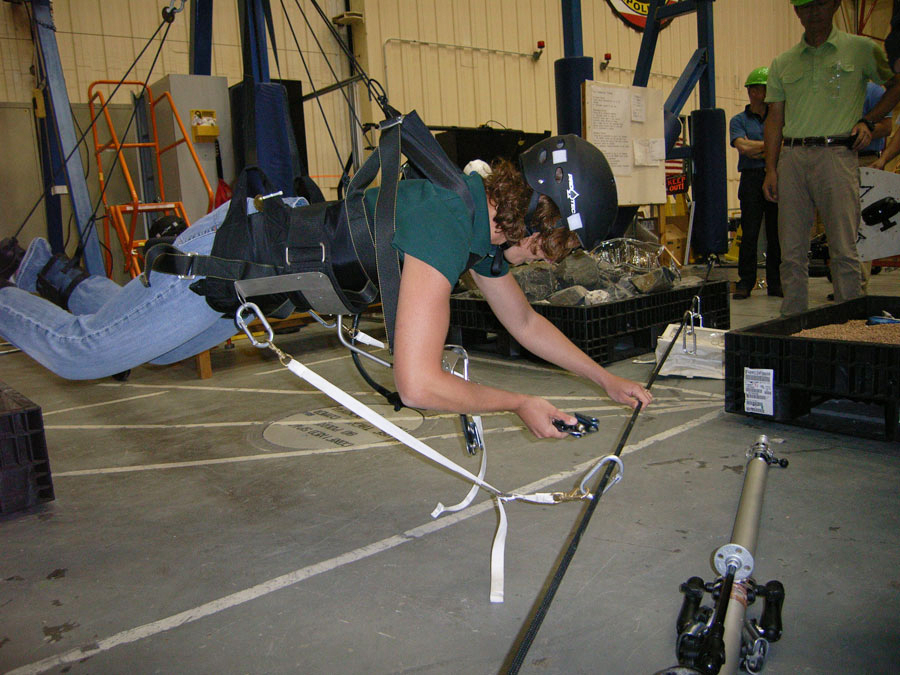The Aquarius undersea habitat is within the Florida Keys National Marine Sanctuary. It is owned by the National Oceanic and Atmospheric Administration; NASA leases it once a year.
President Obama has said that the nation would have a new spacecraft designed for manned expeditions beyond the moon by 2025, starting with a mission to an asteroid.
To preview NASA’s first flight to an asteroid, astronaut Dottie Metcalf-Lindenburger is spending two weeks on the floor of the Atlantic Ocean.
The former Hudson’s Bay High School teacher is commanding an international mission — NEEMO 16 — in the world’s only undersea laboratory this month.
The four-person team arrived Monday at Aquarius, a habitat in 60 feet of water about four miles off Key Largo, Fla.
While NEEMO (NASA Extreme Environment Mission Operations) isn’t in orbit, the seafloor lab helps aquanauts work and train under similar conditions. They’re living in isolation and sharing tight quarters. A job assignment involves suiting up in life-supporting gear and using tools in reduced gravity.
In a NASA interview videotaped before the mission, Metcalf-Lindenburger called it “a really good opportunity to work together in an extreme environment, much like space, with life support systems, power sources and all the things we need to keep us alive.”
Metcalf-Lindenburger knows what that’s like. She was aboard the International Space Station in 2010 as part of Discovery’s STS-131 shuttle mission. Metcalf-Lindenburger, 37, has logged 362 hours in space.
Her NEEMO 16 teammates are planetary scientist Steven Squyres, from Cornell University; British astronaut Timothy Peake, with the European Space Agency; and astronaut Kimiya Yui, with the Japan Aerospace Exploration Agency.
Their habitat has about 400 square feet of living quarters and lab space. The habitat’s interior atmospheric pressure is equal to the surrounding water pressure; that means the “wet porch” entryway to the ocean can remain open, and sea water will not flow into the crew’s dry living quarters and the lab. However, at the end of their mission, the aquanauts must undergo almost 16 hour of decompression.
NEEMO 16 was designed to simulate a mission to a near-Earth asteroid.
“We want to learn before we go out and explore in space,” she said. “We’re going to be trouble-shooting, and finding out ways to work near an asteroid. Is it better to be tethered, is it better to be working off a space-exploration vehicle?
“The first few days will be space walks, as if we were tethered to an asteroid,” she said in the NASA video.
The tasks will include taking rock samples. While that’s pretty basic hands-on research, it comes with some challenges in weightlessness.
“If you do something as simple as hit a rock with a hammer, you’re going to go flying off into space,” Squyres said in an interview with National Public Radio that aired Sunday.
Metcalf-Lindenburger got a taste of zero-gravity manual labor in April during a week of training at the Johnson Space Center. She was strapped into what NASA calls an Active Response Gravity Offload System, or ARGOS. It looks to be a distant cousin to the sort of rig an actor would use for flying around in a stage production of “Peter Pan.”
After a week of underwater space-walk training, the crew will test manned submersibles, simulating the small space vehicles that will serve as work platforms.
“We will be doing some hovering, and working with these space vehicles near the asteroid, ” Metcalf-Lindenburger said.
There are other mission objectives: NASA wants to know how a communication lag will affect mission operations and the mental health of the crew.
“There will be a 50-second delay,” Metcalf-Lindenburger said.
NASA also needs to know the optimum crew size for an extended mission: three? four? five?
In a NASA blog post, Metcalf-Lindenburger discussed what’s awaiting us in the asteroid belt.
“Future missions to these asteroids could help us learn more about deep-space exploration and the beginnings of our solar system,” she wrote.
Depending on their mineral content, future missions to asteroids could serve as prospecting and mining expeditions.
And let’s not forget planetary defense, Metcalf-Lindenburger wrote. Those manned missions could help us develop options for dealing with asteroids that threaten Earth.
Tom Vogt: 360-735-4558; http://www.twitter.com/col_history; tom.vogt@columbian.com.




